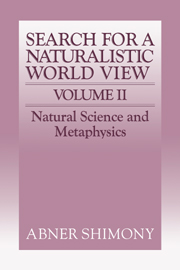Book contents
- Frontmatter
- Contents
- A MEASUREMENT IN QUANTUM MECHANICS
- 1 Role of the observer in quantum theory
- 2 Approximate measurement in quantum mechanics
- 3 Proposed neutron interferometer test of some nonlinear variants of wave mechanics
- 4 Desiderata for a modified quantum dynamics
- 5 Filters with infinitely many components
- 6 Proposed neutron interferometer observation of the sign change of a spinor due to 2π precession
- B QUANTUM ENTANGLEMENT AND NONLOCALITY
- C COMPLEX SYSTEMS
- D TIME
- E THE MENTAL AND THE PHYSICAL
- Index
6 - Proposed neutron interferometer observation of the sign change of a spinor due to 2π precession
Published online by Cambridge University Press: 05 June 2012
- Frontmatter
- Contents
- A MEASUREMENT IN QUANTUM MECHANICS
- 1 Role of the observer in quantum theory
- 2 Approximate measurement in quantum mechanics
- 3 Proposed neutron interferometer test of some nonlinear variants of wave mechanics
- 4 Desiderata for a modified quantum dynamics
- 5 Filters with infinitely many components
- 6 Proposed neutron interferometer observation of the sign change of a spinor due to 2π precession
- B QUANTUM ENTANGLEMENT AND NONLOCALITY
- C COMPLEX SYSTEMS
- D TIME
- E THE MENTAL AND THE PHYSICAL
- Index
Summary
If a spin-½ particle is placed in a constant uniform magnetic field for a time t during which, classically, the Larmor precession angle would be θ, then according to quantum mechanics the components of the spin part of the wave function undergo phase changes of ±θ/2. Hence, corresponding to a classical precession of 2π radians, there is a sign change of the spinor, whatever the initial polarization may be. Bernstein pointed out that this sign change can be observed by coherently splitting a fermion beam, subjecting one part to the magnetic field, and coherently recombining the parts. Evidently, the same interference effect can be achieved by subjecting the two parts of the beam to fields which would classically cause precessions of π radians in opposite senses. He noted advantages in studying neutral rather than charged particles, and outlined a proposal for an interferometry experiment with neutrons.
The recent invention and application of a remarkable single-crystal neutron interferometer greatly increases the feasibility of observing the sign change. In the experiment of Ref. 3 a neutron beam is split, and the two parts follow paths of different elevations. The interference of the recombined parts exhibits the effect of gravitational potential difference between the two elevations. In the experiment which we propose, the paths could be kept at the same elevation, but phase differences would be produced by appropriate magnetic fields.
Information
- Type
- Chapter
- Information
- The Search for a Naturalistic World View , pp. 72 - 74Publisher: Cambridge University PressPrint publication year: 1993
